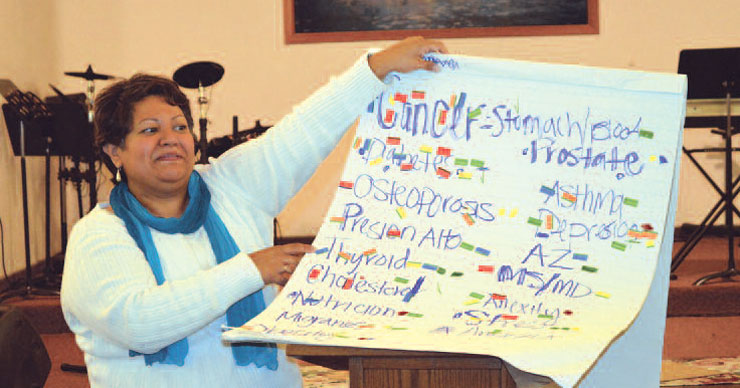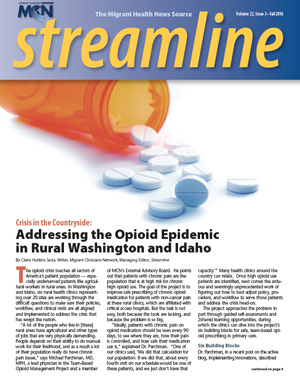Promotores as Needs Assessment Champions

By Claire Hutkins Seda, Writer, Migrant Clinicians Network, Managing Editor, Streamline
Needs assessments are a unique opportunity to gain insight into the communities a health center serves — and a great way to assure a health center is on the right track with its programs and services. So, engaging and relying on the health center’s outreach team is a natural fit. At Moses Lake/Quincy Community Health Center, halfway between Yakima and Spokane in central Washington, Mary Jo Ybarra-Vega, MS, LMHC, and Maria Blancas have been steering each step of their health center’s needs assessment process as an integral part of their daily work as promotoras, community health workers serving the migratory agricultural worker community. “When you talk about needs assessments, promotoras are doing needs assessments all the time,” Ybarra-Vega, Outreach/Behavioral Health Coordinator, said. “They are the ones who go get the data,” but they can also lead the process. Partnering with the health center’s promotores, Ybarra-Vega says, is the most efficient and effective way to best ensure that the health center’s services are truly meeting the needs of the community. What’s more, the healthy, long-term relationships that promotores have with the community can help the health center maintain ongoing support and flexibility as the community’s needs shift — and to prioritize funding to make sure that level of support is possible.
What is a needs assessment?
A needs assessment is just as it sounds: a process under which a health center evaluates and re-evaluates program effectiveness, to determine if it is reaching out to the full community in its service area and serving the needs that the community has. Each health center program grantee under Section 330 must undertake a needs assessment, and each health center approaches it differently. “It is a requirement — but it’s also the principle of being a health center that is serving the underserved; you want to make sure that you’re being responsive,” Liam Spurgeon, Associate Project Manager at Health Outreach Partners (HOP) said. “It’s a big undertaking.”
HOP provides training, technical assistance, and information services to health centers, primary care associations, and other community- based organizations around the country. A National Cooperative Agreement through the Health Resources and Services Administration (HRSA), HOP’s goal is to build strong and sustainable grassroots health models to increase access for underserved populations. They have been key in many health centers’ needs assessments processes, and have been an important resource for Moses Lake/Quincy, Ybarra-Vega said.
For many health centers, the needs assessment is a yearlong or multi-year process, replete with surveys and extra funding and staff meetings. For Quincy Community Health, part of Moses Lake/Quincy, it’s an ongoing and integral part of the day-to-day operations. “Health centers should always be doing something to assure that they are responding to the needs of their population because needs change — and health centers need to keep that in mind, to make sure that they’re checking in with their communities, to make sure that their services are appropriate,” Spurgeon explained. “If they find out that their needs are something else, [they need to] figure out how to adapt to those needs.”
There isn’t one correct way to completing a needs assessment, Spurgeon noted, but HOP does offer a comprehensive needs assessment toolkit that encompasses the basic processes. (Learn more about the toolkit in “Needs Assessments, Step-By-Step with Health Outreach Partners” in the autumn 2015 issue of Streamline.) The first step is defining specifically what the health center wishes to obtain from the process. After defining the key steps and goals, the health center plans how to roll out the assessment. The third step, developing data collection tools, is followed by the actual collection and analyzation of data. Finally, the health center and its team share the results and use the findings to adjust its programs and services and to prioritize and develop new actions to better address the needs of the community. “Maybe your health center doesn’t have the resources, but it’s a good way to find out [what’s really needed], and then maybe you can make a good case for funding or change your services to adapt to the need,” Spurgeon noted.
Ongoing work
At Moses Lake/Quincy, the process starts with the promotores. “Our [process] is very organic,” Ybarra-Vega admits. But she believes it works. Every year, they use their “bolita method,” says Blancas, Outreach Coordinator and longtime volunteer promotora at Moses Lake. With the bolitas, (Spanish for “little dots”), the outreach team hosts meetings throughout the service area in which “everyone gets three little round stickers,” she said, where “they get to pick the three most important issues.” The method helps guide the process and also provides a low-literacy format to encourage greater participation. The outreach team collects and tallies the votes. Then, the team meets one-on-one with providers to ask what issues and concerns they have been hearing, and what they’d like to see the health center focus on in the coming year. Finally, the outreach team meets as a group to discuss its own perspectives, and to develop its plans in response to the assessments. When the outreach team renews its meetings the next year, it provides a summary of the previous year’s concerns and how the health center responded. This format provides the base of the health center’s formal needs assessment. In this way, Moses Lake/Quincy has integrated its needs assessment process into a cornerstone of its outreach team’s work.
Blancas and Ybarra-Vega point out that their ongoing process is especially adept at responding to new and changing community needs. In recent years, massive and unprecedented wildfires have raged through the community. During one fire, mandatory evacuations were in place — but the local migratory agricultural worker community was not kept informed. “We started to hear about it from another promotora,” Ybarra-Vega recalled. “One of the waitresses [that she knew] knew a worker at a labor camp,” who said that when the sheriff came to announce a level three evacuation, the farm manager gathered his family and left — without informing the farm crew. The promotores began to recognize a gap in emergency preparedness. “What happened is as we started doing our needs assessments with the bolitas, these issues came up [there], too,” Ybarra-Vega said. In response, a volunteer promotora/premed student, Emma Zavala-Suarez, developed a two-page Spanish emergency preparedness informational sheet working with the Grant County Sherriff Department and their existing document. Partnering with Molina Health Care, the team assembled emergency kits and the two-page sheets. At a national Stream Forum sponsored by North West Primary Care Association in San Diego, a panel presentation was held to get the community in on the conversation, and to inform state and federal authorities of the issue. Visits to the migrant camps continue and now the promotores also distribute the new materials to ensure that migratory agricultural workers won’t be left behind in the next big emergency.
While the process checked off the needs assessment box for the health center, it also proactively addressed serious and new concerns in the health center’s patient population. Should the issue no longer be of concern among the patients, providers, and outreach team, the health center will adjust its tactics to better reflect newer concerns as they come. An added bonus is a better pulse on the community at large. When Ybarra-Vega grew up in Quincy, she says only a handful of Latinos lived in the region. By the time Blancas joined in, “it was about 50/50” between Latinos and non-Latinos. Now, she says, a vast majority of the population in the community are Latino — and that, too, comes out as they do their needs assessments, which further informs their programs and services.
Ybarra-Vega is proud of the “level of personal commitment” that her team of outreach workers has demonstrated, time and time again, and she encourages other health centers to give the outreach team the lead in developing and executing needs assessments. “They have the heart, they know how important it is to ask the community, to get them involved, to get the youth involved… We’ve become a change agent in town. I think our community [has been] transformed,” Ybarra-Vega said. “We are always getting better and trying to improve… but we feel honored to do the work that we do, with the population that we work with.”
Resources
- Health Outreach Partners is at www.outreach-partners.org. They offer short “coffee break” webinars, including the recent “Three Key Lessons Learned From Needs Assessments”
- Contact Liam Spurgeon at HOP to request a copy of HOP’s Needs Assessment Toolkit, at liam@outreachpartners.org.
- Visit Moses Lake/Quincy’s website at https://www.mlchc.org

Read this article in the Fall 2016 issue of Streamline here!
Sign up for our eNewsletter to receive bimonthly news from MCN, including announcements of the next Streamline.
Return to the Streamline Fall 2016 Table of Contents.